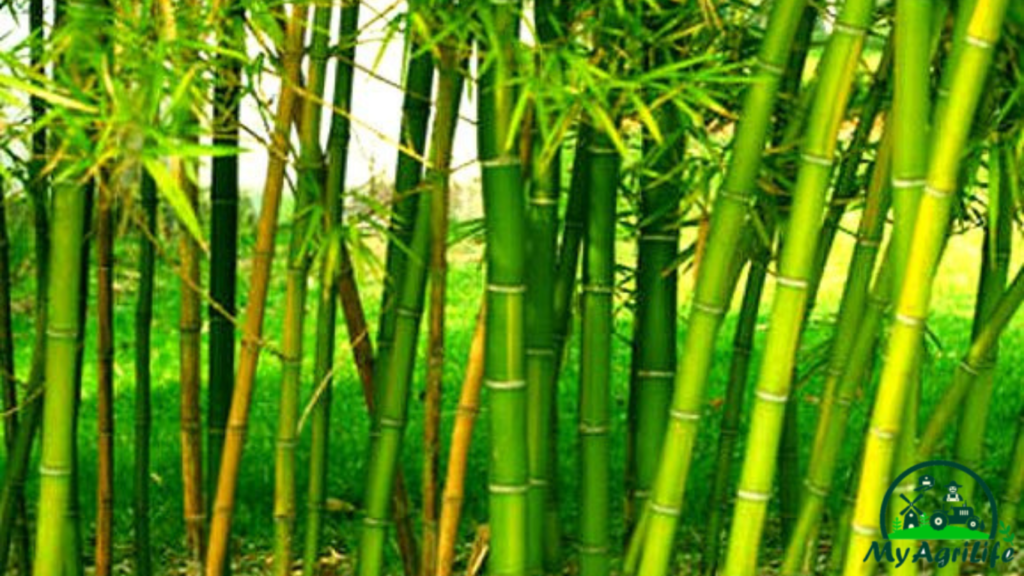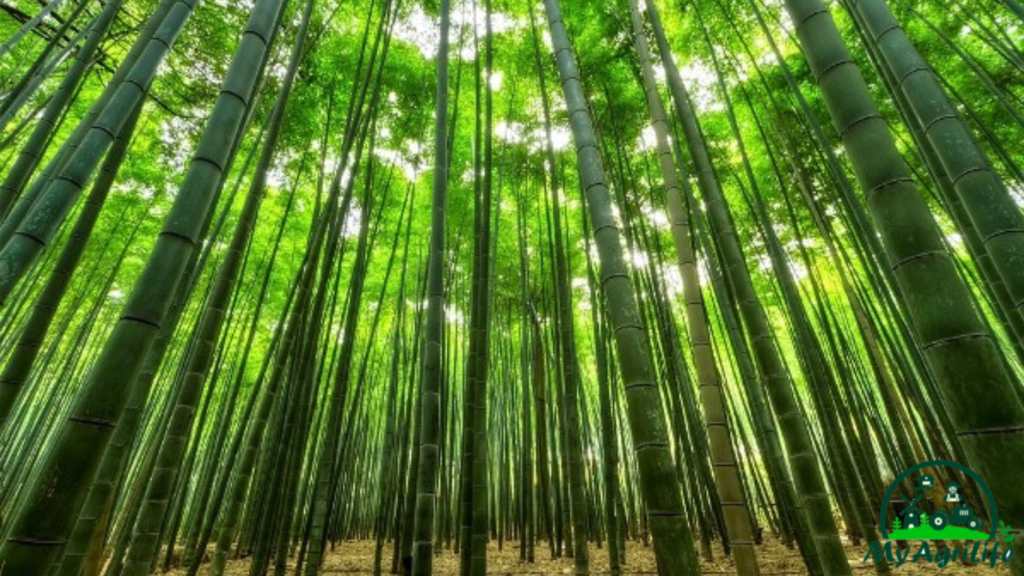Bamboo, also known as (baans) in Hindi, is a type of fast-growing grass that belongs to the family Poaceae. It is found in various parts of the world, including Asia, Africa, and the Americas, and is known for its versatility, strength, and durability.

Bamboo has a wide range of uses, such as construction, furniture-making, paper production, and even as a food source for humans and animals. It is also used for decorative purposes, such as in flower arrangements and as a design element in home decor.
In many parts of Asia, bamboo is a symbol of good luck, strength, and flexibility. It is also used in traditional medicine to treat a variety of ailments.
Due to its rapid growth rate and ability to regenerate quickly, bamboo is considered to be a sustainable and eco-friendly material. It is often used as a substitute for traditional hardwoods, which take much longer to grow and are not as environmentally friendly.
Seed Specification Bamboo
The seed specification of bamboo can vary depending on the species. However, generally, bamboo seeds are small and light. They are usually about 1-2 mm in size nd have a hard outer shell.
Bamboo seeds are typically propagated through vegetative means, such as rhizome cuttings or divisions, rather than through seed propagation. This is because bamboo seeds are difficult to obtain and are not always viable. In fact, some species of bamboo only flower and produce seeds once every several decades or even longer.
When bamboo seeds are available, they are usually collected from mature bamboo plants that have flowered and produced seeds. The seeds are then cleaned and stored in a cool, dry place until they are ready to be sown.
It is important to note that not all species of bamboo produce viable seeds, and even when they do, the resulting plants may not be true to the parent plant. Therefore, vegetative propagation is often the preferred method for growing bamboo.
Land Preparation & Soil Health Bamboo
Land preparation and soil health are important factors to consider when growing bamboo. Here are some guidelines to follow:
1.Site selection: Choose a site that is well-drained, with good sunlight exposure and protection from strong winds.
2.Soil preparation: Clear the site of any weeds, debris, and rocks. Bamboo prefers a well-draining soil with a slightly acidic to neutral pH (between 5.5 and 7.0). Incorporating organic matter such as compost or manure can help improve soil fertility and structure.
3.Soil testing: It is important to test the soil before planting bamboo. A soil test will determine the soil pH, nutrient levels, and other factors that can affect plant growth. Based on the soil test results, you can determine if any soil amendments are needed to improve soil health.
4.Fertilization: Bamboo requires nitrogen for healthy growth. Depending on the soil fertility and bamboo species, you may need to apply nitrogen fertilizer to promote growth.
5.Mulching: Adding a layer of organic mulch around the base of the bamboo plants can help retain soil moisture, suppress weed growth, and provide nutrients as it breaks down.
6.Irrigation: Bamboo requires regular watering, especially during the first few years of growth. Provide sufficient water to keep the soil moist but not waterlogged.
7.Crop rotation: To maintain soil health, it is recommended to rotate bamboo with other crops to prevent soil depletion and pest and disease buildup.
In summary, preparing the land and maintaining soil health are crucial for growing healthy and productive bamboo plants. Testing the soil, incorporating organic matter, fertilizing as needed, mulching, and providing sufficient irrigation are key steps to ensuring success.
Crop Spray & Fertilizer Specification Bamboo
Crop spraying and fertilization are important practices for promoting healthy growth and productivity in bamboo plants. Here are some guidelines to follow for crop spraying and fertilizer specification:

Crop Spraying
1.Timing: The best time to spray bamboo is early in the morning or late in the afternoon when the leaves are dry. Avoid spraying during midday or when the weather is hot and sunny.
2.Frequency: The frequency of crop spraying depends on the bamboo species, pest and disease pressure, and weather conditions. As a general guideline, spray bamboo once every 10-14 days during the growing season.
3.Pest and disease control: Common pests that affect bamboo include scales, mealybugs, and borers, while common diseases include fungal infections and bacterial blight. Use an appropriate insecticide or fungicide to control pests and diseases as needed.
4.Application method: Use a sprayer to apply the spray evenly over the bamboo plants. Be sure to cover both the upper and lower leaf surfaces.
Fertilizer Specification
1.Timing: Fertilize bamboo during the growing season, typically from spring to fall.
2.Fertilizer type: Bamboo requires a balanced fertilizer that contains nitrogen, phosphorus, and potassium (N-P-K). The ideal ratio is 10-10-10 or 12-12-12.
3.Amount: The amount of fertilizer to apply depends on the age of the bamboo plants and the soil fertility. As a general guideline, apply 1-2 pounds of fertilizer per 100 square feet of bamboo plantation.
4.Application method: Apply the fertilizer evenly over the bamboo plantation, and water it in thoroughly.
5.Organic fertilizer: Organic fertilizers such as compost, manure, and bone meal can also be used to fertilize bamboo. These fertilizers provide slow-release nutrients and improve soil health.
In summary, crop spraying and fertilization are important practices for promoting healthy growth and productivity in bamboo plants. Use appropriate insecticides or fungicides to control pests and diseases, and fertilize with a balanced fertilizer that contains nitrogen, phosphorus, and potassium. Apply crop spray and fertilizer according to the guidelines mentioned above, and always follow the manufacturer’s instructions for best results.
Harvesting & Storage Bamboo
Harvesting and storage are important aspects of bamboo cultivation. Here are some guidelines to follow for harvesting and storing bamboo:
Harvesting
1.Harvesting time: The best time to harvest bamboo depends on the intended use and the bamboo species. For construction purposes, bamboo is typically harvested when it reaches 3-5 years of age, as the culms are stronger and more durable. For handicrafts and other decorative purposes, bamboo can be harvested at any age.
2.Harvesting method: Bamboo can be harvested by cutting the culms at the base using a sharp saw or machete. Be sure to cut at an angle to prevent water from accumulating on the cut surface.
3.Harvesting frequency: The frequency of bamboo harvesting depends on the bamboo species and the intended use. Some species can be harvested every year, while others may take several years to regrow.
4.Harvesting quantity: Do not harvest more than 30% of the total bamboo plantation in any given year. This will help ensure that the plantation remains productive and healthy.
Storage
1.Cleaning: After harvesting, remove any leaves or branches from the bamboo culms. Use a soft brush or cloth to clean the culms.
2.Drying: Bamboo culms should be allowed to dry in a shaded, well-ventilated area for 1-2 weeks. This will help reduce moisture content and prevent mold growth.
3.Treatment: To prevent insect and fungal infestations, bamboo culms can be treated with a preservative such as borax or boric acid. Apply the preservative to the cut ends of the culms.
4.Storage location: Store dried and treated bamboo culms in a cool, dry place, away from direct sunlight and moisture. Storing them in a shed or garage is ideal.
In summary, harvesting and storage are important aspects of bamboo cultivation. Harvest bamboo when it reaches the appropriate age and use a sharp saw or machete. Do not harvest more than 30% of the total plantation. After harvesting, clean and dry the bamboo culms, treat them with a preservative, and store them in a cool, dry place. Following these guidelines will help ensure that the bamboo is of high quality and suitable for its intended use.
Conclusion
In conclusion, bamboo farming is a sustainable and profitable agricultural practice that has numerous environmental and economic benefits. Bamboo is a versatile plant that can be used for various purposes, such as construction, furniture, handicrafts, and paper production. Bamboo is also a fast-growing plant that can sequester large amounts of carbon dioxide and help mitigate climate change.
To start a successful bamboo farming operation, it is important to select the appropriate bamboo species, prepare the land properly, and maintain soil health through regular fertilization and crop spraying. Harvesting and storage are also crucial aspects of bamboo farming, and it is important to follow proper techniques to ensure high-quality bamboo for various uses.
Overall, bamboo farming is a great option for farmers and landowners looking for a sustainable and profitable alternative to traditional agricultural practices. By following proper cultivation techniques and utilizing the many benefits of bamboo, farmers can enjoy increased profits while contributing to a healthier environment.









